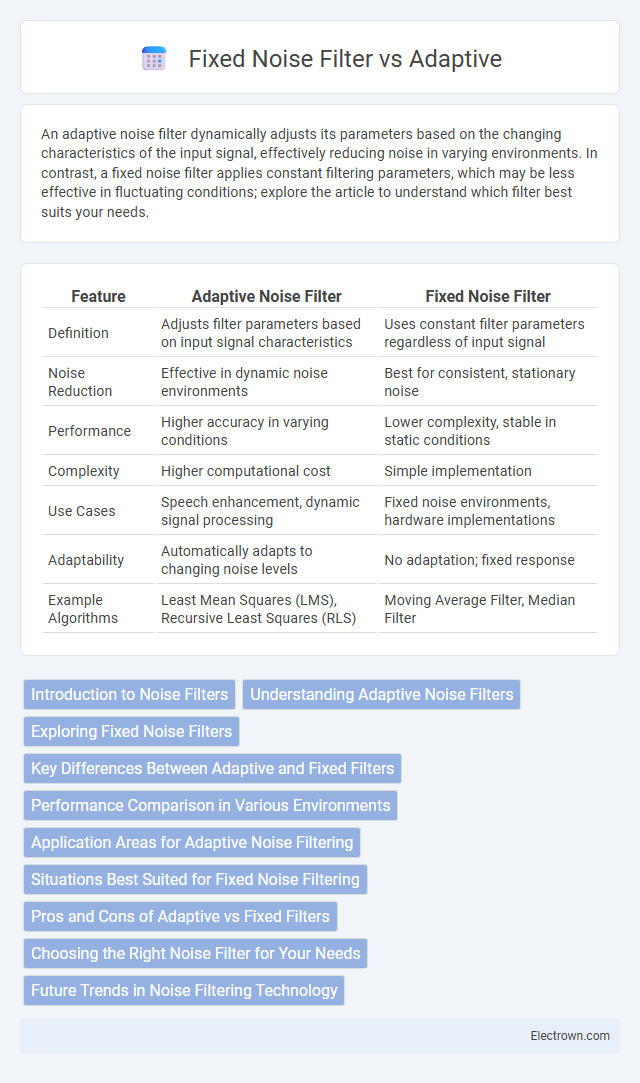An adaptive noise filter dynamically adjusts its parameters based on the changing characteristics of the input signal, effectively reducing noise in varying environments. In contrast, a fixed noise filter applies constant filtering parameters, which may be less effective in fluctuating conditions; explore the article to understand which filter best suits your needs.
Table of Comparison
| Feature | Adaptive Noise Filter | Fixed Noise Filter |
|---|---|---|
| Definition | Adjusts filter parameters based on input signal characteristics | Uses constant filter parameters regardless of input signal |
| Noise Reduction | Effective in dynamic noise environments | Best for consistent, stationary noise |
| Performance | Higher accuracy in varying conditions | Lower complexity, stable in static conditions |
| Complexity | Higher computational cost | Simple implementation |
| Use Cases | Speech enhancement, dynamic signal processing | Fixed noise environments, hardware implementations |
| Adaptability | Automatically adapts to changing noise levels | No adaptation; fixed response |
| Example Algorithms | Least Mean Squares (LMS), Recursive Least Squares (RLS) | Moving Average Filter, Median Filter |
Introduction to Noise Filters
Noise filters are essential components in audio and communication systems to reduce unwanted sound or interference. Adaptive noise filters adjust their parameters dynamically based on the input signal characteristics, providing better performance in changing environments. Fixed noise filters use pre-set parameters optimized for consistent noise conditions, offering simplicity but less flexibility compared to adaptive filters.
Understanding Adaptive Noise Filters
Adaptive noise filters adjust their parameters dynamically based on the changing characteristics of the input signal, enabling effective noise reduction in variable environments. Fixed noise filters utilize predetermined settings that are optimized for specific, unchanging noise conditions but may underperform when noise patterns vary. Understanding adaptive noise filters helps you achieve more precise signal clarity by continuously optimizing filtering in real-time applications.
Exploring Fixed Noise Filters
Fixed noise filters maintain a constant filtering level regardless of changes in the audio environment, making them ideal for controlled settings with predictable noise patterns. These filters use pre-set parameters optimized for specific types of background noise, ensuring consistent noise reduction without processing overhead. While less flexible than adaptive filters, fixed noise filters provide reliable and efficient noise suppression in environments with stable acoustic characteristics.
Key Differences Between Adaptive and Fixed Filters
Adaptive noise filters continuously adjust their filtering parameters based on the input signal characteristics, making them effective in dynamic and unpredictable noise environments, while fixed noise filters use preset parameters optimized for a specific noise profile. Adaptive filters excel in scenarios where noise patterns change over time, such as real-time audio processing or communication systems, whereas fixed filters perform best in consistent, stable noise conditions. Your choice between adaptive and fixed filters should consider the variability of the noise and processing complexity requirements.
Performance Comparison in Various Environments
Adaptive noise filters adjust dynamically to changing sound environments, providing superior performance in complex or fluctuating noise conditions by continuously analyzing and reducing unwanted sounds. Fixed noise filters use preset parameters, offering stable performance in consistent noise environments but often underperforming when noise patterns vary significantly. Your choice between adaptive and fixed noise filters impacts audio clarity, especially in environments with unpredictable or rapidly changing noise levels.
Application Areas for Adaptive Noise Filtering
Adaptive noise filtering excels in dynamic environments where signal characteristics constantly change, such as telecommunications, audio processing, and biomedical signal analysis. Its ability to adjust filter parameters in real-time makes it ideal for applications involving speech recognition, radar systems, and hearing aids. Your systems benefit from improved noise reduction and signal clarity when implementing adaptive noise filters in these complex, variable scenarios.
Situations Best Suited for Fixed Noise Filtering
Fixed noise filtering is best suited for environments with consistent and predictable noise patterns, such as factory floors or HVAC systems where background noise remains steady. This filter efficiently removes constant noise frequencies without altering the primary signal, making it ideal for applications like telephony or audio recording in controlled settings. Its simplicity and low computational cost also benefit real-time systems where quick and reliable noise reduction is necessary.
Pros and Cons of Adaptive vs Fixed Filters
Adaptive noise filters automatically adjust their parameters based on changing signal characteristics, providing superior performance in dynamic or non-stationary noise environments. Fixed noise filters use constant parameters, offering simplicity and low computational requirements but may struggle with varying noise conditions. While adaptive filters excel in versatility and accuracy, they demand higher processing power and complexity, whereas fixed filters ensure stability and ease of implementation in predictable noise scenarios.
Choosing the Right Noise Filter for Your Needs
Selecting between adaptive and fixed noise filters depends on the specific environment and noise variability. Adaptive noise filters dynamically adjust to changing noise patterns, making them ideal for unpredictable or fluctuating soundscapes, while fixed noise filters offer consistent attenuation suited for stable, repetitive noise sources. Evaluating factors such as noise frequency, intensity, and consistency ensures the optimal filter enhances audio clarity and reduces unwanted disturbances effectively.
Future Trends in Noise Filtering Technology
Future trends in noise filtering technology emphasize the integration of advanced machine learning algorithms, enhancing adaptive noise filters' ability to distinguish complex sound environments with greater precision compared to fixed noise filters. Innovations in real-time signal processing and neural network architecture enable adaptive filters to dynamically adjust to varying noise patterns, improving clarity in communication devices and hearing aids. The development of hybrid models combining fixed filter stability with adaptive algorithmic flexibility is poised to revolutionize noise reduction across industries such as telecommunications, automotive, and consumer electronics.
Adaptive vs Fixed Noise Filter Infographic

 electrown.com
electrown.com